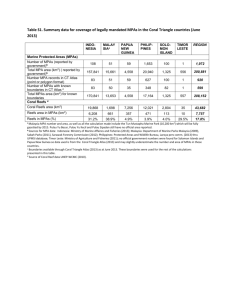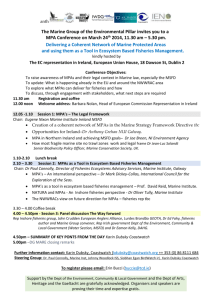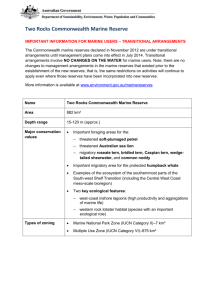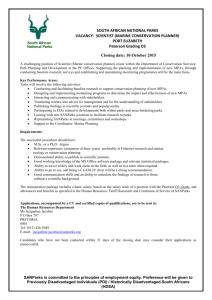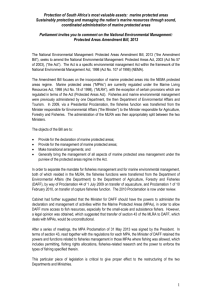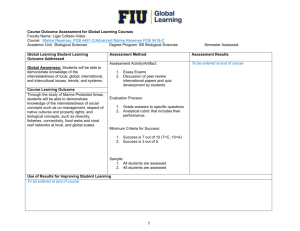WP5 Annotated Bibliography2
advertisement
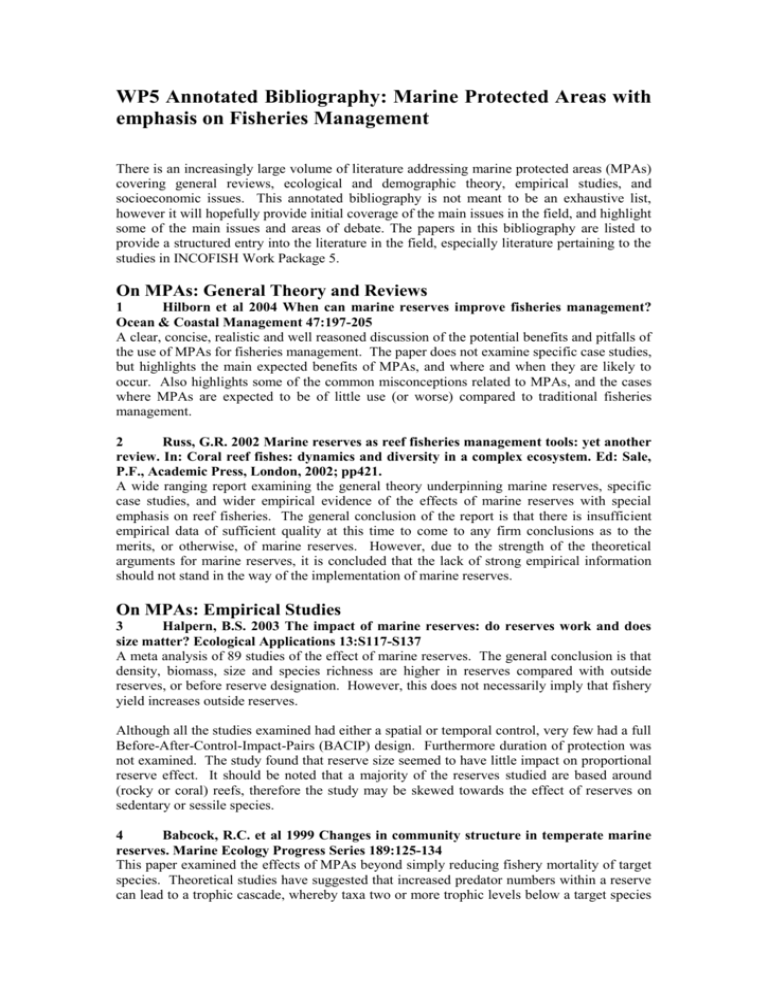
WP5 Annotated Bibliography: Marine Protected Areas with emphasis on Fisheries Management There is an increasingly large volume of literature addressing marine protected areas (MPAs) covering general reviews, ecological and demographic theory, empirical studies, and socioeconomic issues. This annotated bibliography is not meant to be an exhaustive list, however it will hopefully provide initial coverage of the main issues in the field, and highlight some of the main issues and areas of debate. The papers in this bibliography are listed to provide a structured entry into the literature in the field, especially literature pertaining to the studies in INCOFISH Work Package 5. On MPAs: General Theory and Reviews 1 Hilborn et al 2004 When can marine reserves improve fisheries management? Ocean & Coastal Management 47:197-205 A clear, concise, realistic and well reasoned discussion of the potential benefits and pitfalls of the use of MPAs for fisheries management. The paper does not examine specific case studies, but highlights the main expected benefits of MPAs, and where and when they are likely to occur. Also highlights some of the common misconceptions related to MPAs, and the cases where MPAs are expected to be of little use (or worse) compared to traditional fisheries management. 2 Russ, G.R. 2002 Marine reserves as reef fisheries management tools: yet another review. In: Coral reef fishes: dynamics and diversity in a complex ecosystem. Ed: Sale, P.F., Academic Press, London, 2002; pp421. A wide ranging report examining the general theory underpinning marine reserves, specific case studies, and wider empirical evidence of the effects of marine reserves with special emphasis on reef fisheries. The general conclusion of the report is that there is insufficient empirical data of sufficient quality at this time to come to any firm conclusions as to the merits, or otherwise, of marine reserves. However, due to the strength of the theoretical arguments for marine reserves, it is concluded that the lack of strong empirical information should not stand in the way of the implementation of marine reserves. On MPAs: Empirical Studies 3 Halpern, B.S. 2003 The impact of marine reserves: do reserves work and does size matter? Ecological Applications 13:S117-S137 A meta analysis of 89 studies of the effect of marine reserves. The general conclusion is that density, biomass, size and species richness are higher in reserves compared with outside reserves, or before reserve designation. However, this does not necessarily imply that fishery yield increases outside reserves. Although all the studies examined had either a spatial or temporal control, very few had a full Before-After-Control-Impact-Pairs (BACIP) design. Furthermore duration of protection was not examined. The study found that reserve size seemed to have little impact on proportional reserve effect. It should be noted that a majority of the reserves studied are based around (rocky or coral) reefs, therefore the study may be skewed towards the effect of reserves on sedentary or sessile species. 4 Babcock, R.C. et al 1999 Changes in community structure in temperate marine reserves. Marine Ecology Progress Series 189:125-134 This paper examined the effects of MPAs beyond simply reducing fishery mortality of target species. Theoretical studies have suggested that increased predator numbers within a reserve can lead to a trophic cascade, whereby taxa two or more trophic levels below a target species show a response to the change in management (see Paper 11 below). In the case examined, reduction in fish and invertebrate urchin-predators lead to increased urchin numbers and hence increased grazing pressure. Within the reserves, fish and invertebrate urchin-predators had increased in number and mean size, leading to a reduction in urchin numbers and an increase in macroalgal abundance. The increased macroalgal abundance within reserves compared to fished areas lead to higher levels of benthic primary production in reserves compared to fished areas. This suggests that the implementation of reserves can fundamentally alter energy partitioning within an ecosystem. Supporting evidence from other studies is presented and discussed. 5 Murawski, S.A, Brown, R, Lai, H.-L, Rago, P.J. & Hendrickson, L. 2000 Largescale closed areas as a fishery-management tool in temperate marine systems: The Georges Bank experience. Bulletin of Marine Science 66:775-798 Examines the effects of one of the few large scale MPAs to have been implemented in temperate waters. The MPAs were considered to have reduced fishing mortality of many stocks covered by the MPAs, however simultaneous reductions in effort outside the MPAs confounds interpretation. 6 Pastoors, M.A., Rijnsdorp, A.D. & Van Beek, F.A. 2000 Effects of a partially closed area in the North Sea (“plaice box”) on stock development of plaice. ICES Journal of Marine Science 57:1014-1022 The plaice box was established to reduce mortality of undersized plaice (Pleuronectes platessa) in the North Sea. Since implementation of the plaice box yield and SSB have decreased. This may be due to other wider changes simultaneously occurring in the North Sea. The distribution of undersized plaice has also changed since the inception of the plaice box. This indicates that any benefits from static MPAs may be countered by wider environmental changes in the ecosystem, and that specific static MPAs by themselves may only have limited value in hedging against future uncertainty. On MPAs: Theoretical Studies 7 Pelletier, D. & Mahévas, S. 2005 Spatially explicit fisheries simulation models for policy evaluation. Fish and Fisheries 6: 307-349 A wide ranging and well structured review of modelling approaches to the evaluation of the use of MPAs. In addition to population models, the paper examines and discusses ecosystem, management and exploitation models. Although a wide ranging review, it is not a completely comprehensive review of all modelling approaches. 8 Guénnette, S. & Pitcher, T.J. 1999 An age-structured model showing the benefits of marine reserves in controlling overexploitation. Fisheries Research 39:295-303 A classic paper highlighting the essential problem of using MPAs to manage highly mobile stocks; that reserves need to cover a significant proportion of the total area inhabited by the stock to provide meaningful protection. The model examines long term yield and biomass under different conditions. As a very simplified abstraction, based on a cod population, the model only crudely describes the dynamics of a natural population. However the general conclusion is considered to be robust. 9 Quinn, J.F., Wing, S.R. & Botsford, L.W. 1993 Harvest refugia in marine invertebrate fisheries: models and applications to the red sea urchin, Strongylocentrotus franciscanus. American Zoology 33:537-550 A general model examining the application of MPAs to sessile invertebrates with a common larval pool, based upon urchins, including fertilisation and post-settlement dispensatory Allee effects. Finds that highest yield occurs under a no-reserve management scenario, although under these conditions populations are at risk from complete collapse with a slight increase in fishing mortality. (Model assumes constant relative fecundity.) Yields are much more stable with reserves. To ensure wide spread larval settlement the model finds that there should be multiple reserves with the spacing between reserves less than the larval dispersal distance. On MPAs: Ecopath Studies 10 Walters, C, Pauly, D. & Christensen, V. 1999 Ecospace: predictions of mesoscale spatial patterns in trophic relationships of exploited ecosystems, with emphasis on the impact of marine protected areas. Ecosystems 2:539-554 This paper outlines the overall Ecospace approach and strategy. Discussed are the general steps in extending a time dynamic Ecopath/Ecosim model into a spatially explicit model for MPA testing. Some of the strengths and weaknesses of the Ecospace approach to making Ecopath/Ecosim spatially explicit are discussed. Also describes how Ecospace deals with fishers’ behaviour and how fishing effort is spatially distributed. An example model based on the coast of Brunei is presented and some of the biological and trophic conclusions drawn from the modelling are discussed. 11 Zeller, D. & Reinert, J. 2004 Modelling spatial closures and fishing effort restrictions in the Faroe Islands marine ecosystem. Ecological Modelling 172:403-420 An example of a study using the Ecopath/Ecosim/Ecospace approach to theoretically examine different effort and spatial management options for the Faroe Islands fishery. Ten year model simulations indicate that the present area closures are sufficient for rebuilding the major continental shelf demersal stocks, and that opening access to the closed areas would fail to stocks to rebuild. However the model assumes that there would be a 20% increase in trawl effort associated with opening the closed areas, thus confounding efforts to determine the benefits of closed areas compared to simple effort limitation. Deep water species (Greenland halibut and blue whiting) were not aided by the present closure, though that is because the present closures do not cover their deep water habitat. The predicted decline in highly mobile whiting biomass was not affected by a 20% closure of deep water areas, although their decline in biomass was reduced by a 20% reduction in effort. In contrast, for the less mobile halibut, closure of 20% of deep water habitat would almost stop the decline in biomass, however a 20% reduction in effort would lead to a slight rebuilding of stock biomass. The model does not allow for a detail comparison of the benefits of MPAs over effort reduction. Furthermore the model does not account for bycatch or gear-benthos interaction, two areas where MPAs have been predicted, in certain circumstances, to have specific benefits compare to traditional landing and effort controls. 12 Salomon, A.K. et al 2002 Modeling [sic] the trophic effects of marine protected area zoning policies: a case study. Aquatic Ecology 36:85-95 Another example study using the Ecopath/Ecosim/Ecospace approach to theoretically examine different zoning policies of a proposed National Marine Conservation Area off British Columbia, Canada. The paper compares ten year simulation runs of the model with a variety of different management scenarios in operation, these include a core no-take reserve surrounded by a limited access buffer zone, limited aboriginal harvests allowed within the buffer zone or notake reserve, and several small or one large reserve. It is noted that different components within the ecosystem show very different qualitative and quantitative responses to establishment of the MPA, therefore evaluating MPA effectiveness on the basis of one, or a few indicator species could give very different answers depending on the species selected for monitoring. Some factors relating to the selection of useful criteria for evaluating reserve effectiveness are discussed. As noted by Paper 11 (above) spatial heterogeneity in the biomass distribution of predators and prey due to trophic interactions is generated by the MPA. These ‘edge effects’ can reduce some of the benefits of the MPA, especially if fishing intensity is concentrated around the MPA boundaries. No biomass effects for widely dispersing organisms were predicted by the model, with only the low dispersing taxa showing a response to the MPA. A scenario was run with widespread effort reductions outside the MPA in addition to setting up the MPA, in this scenario widely dispersing organisms as well as low dispersing organisms showed a response to the change in management. Furthermore in this case the setting up of the MPA had little extra benefit over and above the widespread effort restrictions. In the comparison of one large or several small MPAs it was found that one large MPA was predicted to have the most beneficial effect. This is because one large MPA has a lower surface area to volume ratio, reducing the ‘edge effects’ and the number of cross boundary movements.
